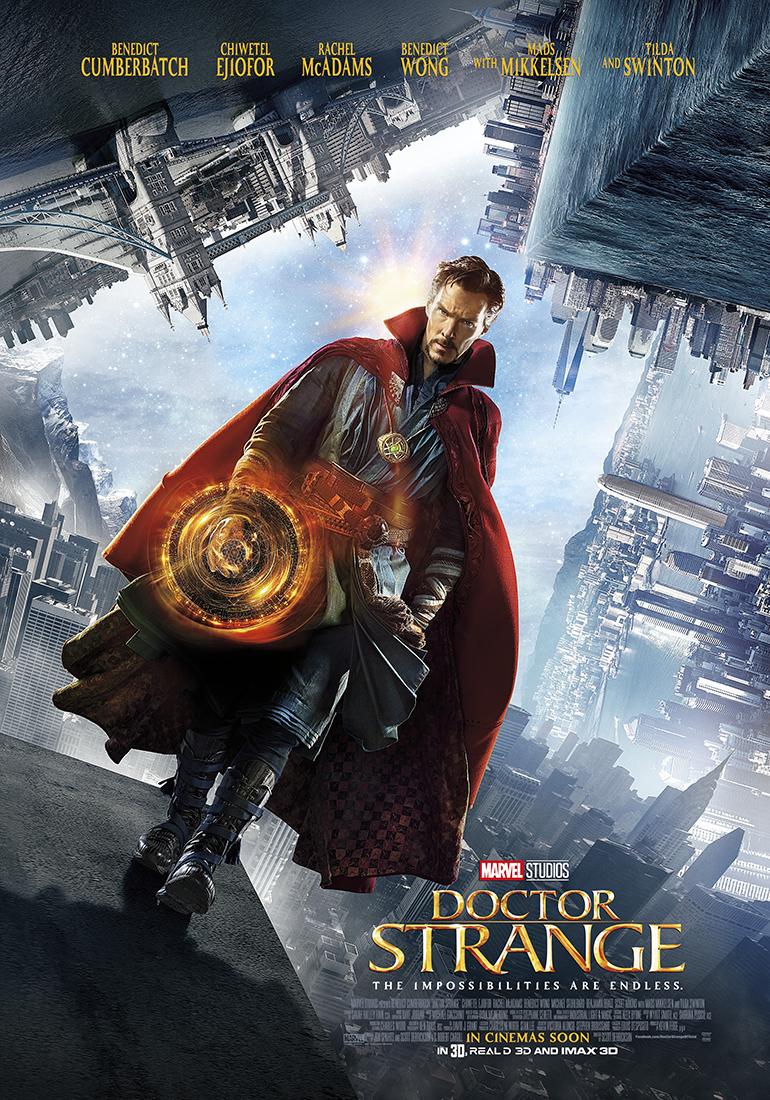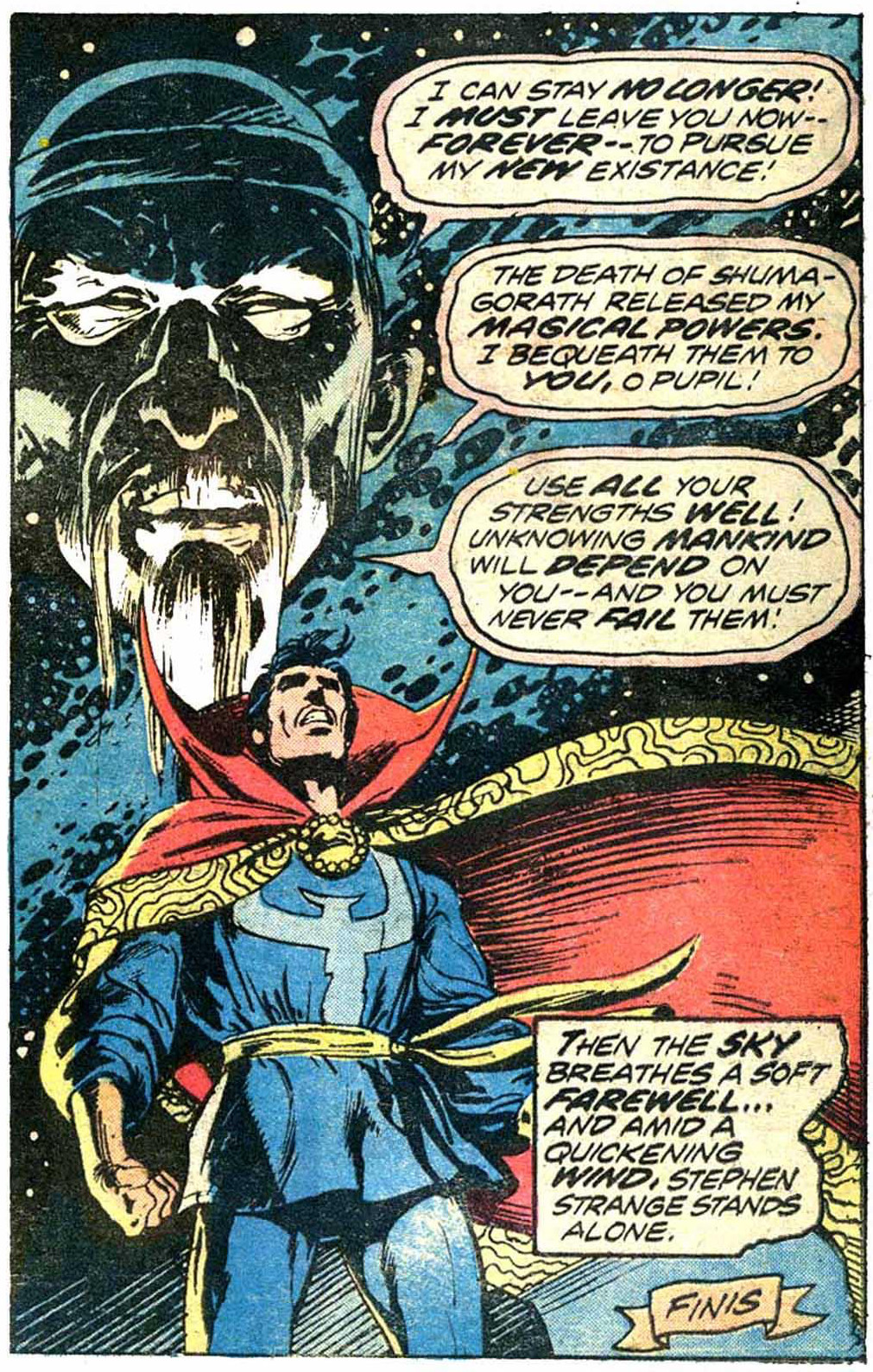Henning's Homepage |
The Blog
ON THIS PAGE
- Review of Doctor Strange
- Curse me for a novice: An introduction to Doctor Strange
- Mary Somerville's autobiography
- Fighting syncretism: The early days
Review of Doctor Strange
2016-10-30 [PDF] [PERMANENT LINK]By creating that last post, I think I sort of committed myself to reviewing the Doctor Strange movie once it arrived. Now it has—so here we go.

The Doctor Strange character started out more or less fully formed in its first comic book story in Strange Tales in 1963, and we learned of the sorcerer's origin only a few issues later. Maybe such a start in medias res could have worked for the movies, maybe not. It would certainly have been something more original than what we got, which is a story that begins somewhat before the beginning and ends just when Stephen Strange has donned the cloak of Sorcerer Supreme and stands ready for the real adventure to commence. This is in the nature of origin stories, and the reason why they can often feel a bit frustrating, I think.
In fact, I found the first quarter of the film to be the weakest, with quite a lot happening on the screen, but not so much with the story. When things take off, however, they really do. Kevin Feige said in a promotional short that they "didn't hold back." He spake Truth.
That said, there is nothing really wrong with the beginning of the tale of Stephen Strange, star surgeon and Douchebag Supreme, either. The writers don't have that pitch-perfect sense for melodrama and comic relief that Joss Whedon has displayed in the Avengers movies (few do), but they don't mistreat the characters or offend against the logic of their motivations, and that goes far indeed to keep me pleased. (This, by the way, is a standard I think we have come to expect of the MCU movies by now, and a reason they keep getting such good marks overall. Maybe it's Disney—they always had a very keen eye for storytelling—or maybe it's Kevin Feige not letting any nonsense past him. Either way, I'm certainly grateful for the consequent quality bump in superhero movies.)
Cumberbatch and the rest of the cast appear to be enjoying themselves, and don't waver when the time comes for the big gestures—and given the psychedelic typhoon of special effects they are constantly competing with (protip: see this one in 3D), it really was required. Tilda Swinton in particular has an almost supernatural presence, and doesn't seem to hate being a timeless mystical sage one bit. Chiwetel Ejiofor and Mads Mikkelsen deliver their material with perfectly sufficient conviction, as does Rachel McAdams in her smaller and less outré part.
Even so, this is one film where the world—the multiverse of alternate dimensions and arcane forces, to be precise—takes center stage. It's in keeping with the Doctor Strange canon. No story ever benefitted from putting its focus somewhere other than on its characters, however, and it is true here as well—but few movies make up for it in a fashion anywhere close to this! The kaleidoscopic lunacy unleashed on the audience, and on an unsuspecting Stephen Strange, is surprisingly effective in making its point: however smart you feel on the streets in your home city—in this world, you don't have a clue. (And you'll have to swallow whatever New Age mumbo jumbo comes with it.)

I don't need a film to be a 9 out of 10 to make me happy, and Doctor Strange gets 7 robust Rings of Raggadorr from me. The characters were treated with respect and given a few nice twists—and the world of sorcery was something to behold. The climax was satisfyingly brainy rather than brawny, as in any characteristic Doc Strange story—even if it maybe didn't make absolutely flawless sense. (This, too, is tradition.)
As satisfied as I am with what we got, I still can't quite liberate myself from thoughts about what might have been—considering that, years ago, this film was to be directed by Guillermo del Toro (Hellboy I and II, Pan's Labyrinth) from a script by Alex Proyas (Dark City). I think this would have meant less of the Inception aesthetic, and more of the H.P. Lovecraft tone, that has periodically existed in the comic. (See: Shuma-Gorath.) I would have enjoyed that.
As for consistency with canon, I don't worry about it too much. There were no disturbing deviations, and most of them were either introduced in recent comics, absolutely necessary (Wong), or just good ideas (Mordo). I enjoyed seeing the Wand of Watoomb, but thought it seemed a bit underpowered here as compared to the comic, got curious about "the scepter of the Living Tribunal," and was amused to learn that the Eye of Agamotto does not reveal Truth in this version—for reasons of the long MCU arc, etc. (I tell you, at this point, Avengers: Infinity War better deliver…)
Sit through both post-credit scenes for hints on the continuing saga of the Sorcerer Supreme. Doctor Strange, no doubt, will remain a whisper in the shadows until his return on the big screen.
Curse me for a novice: An introduction to Doctor Strange
2016-10-24 [PDF] [PERMANENT LINK]
A friend joked a while back that I ought to give our movie gang a presentation on Doctor Strange (Sorcerer Supreme!), in preparation of the premier of Marvel's big new movie about the character. You know, with slides and stuff. Haha. Well, just to demonstrate how this is not a joking matter, I went ahead and made a presentation.
The presentation (link below) is focused on the classic Doctor Strange of the comics, by which I mean 1963 up until the late 80's or so. This is the period when the good doctor had his own magazine most of the time. A lot has happened since then, and a new regular Doctor Strange comic book was started in 2015. I think the film uses a lot of later developments and retcons. My presentation is good for someone who knows little about the old, classic stuff. It is a PDF file best viewed in wide- and fullscreen (like a presentation).
And here it is, for your illumination: Curse Me For A Novice! (Or: An Introduction to the Classic Doctor Strange)

Mary Somerville's autobiography
2016-02-04 [PDF] [PERMANENT LINK]I recently read Mary Somerville's (1780–1872) autobiography. While sometimes a little too focused on dinner parties and social life—at least for someone whose main interest is in her role in the history of science—it is still a very rewarding read, especially the early parts that recount her struggles as a young woman to be allowed to study the things, mathematics and natural science, that she obviously had such exceptional talent for. She was also an explicit liberal and feminist, and her outspoken stance here is also interesting, informative, and in a way encouraging. The text has been out of copyright for a long time and is available for download at the Gutenberg Project.
If you know nothing of Somerville, there is a brief biography here.
Eventually, her skills and talents were recognized throughout Europe. William Whewell was so taken by her translation and elaboration of Laplace's Mécanique céleste that he burst into poetry! Feel his plea, and free to choose, to put some rhymes in your reviews.
TO MRS. SOMERVILLE, ON HER "MECHANISM OF THE HEAVENS"
Lady, it was the wont in earlier days
When some fair volume from a valued pen,
Long looked for, came at last, that grateful men
Hailed its forthcoming in complacent lays:
As if the Muse would gladly haste to praise
That which her mother, Memory, long should keep
Among her treasures. Shall such usage sleep
With us, who feel too slight the common phrase
For our pleased thoughts of you, when thus we find
That dark to you seems bright, perplexed seems plain,
Seen in the depths of a pellucid mind
Full of clear thought, pure from the ill and vain
That cloud the inward light? An honoured name
Be yours; and peace of heart grow with your growing fame
Fighting syncretism: The early days
2015-12-10 [PDF] [PERMANENT LINK]Syncretism is the historical process by which different belief systems, typically religions, are fused into a new belief system. As is easy to imagine, it happens a lot, as cultures interact and overlap over long time-periods.
It is particularly likely in times of conquest and empire-building, as in the days of Alexander the Great, which introduced new routes of influence throughout southern Europe, the Middle East, and India—or when the Roman Empire exposed Europe to Christianity—or when European colonialism did the same for the rest of the world.
Being just one part of a long evolving history of storytelling is of course a problem for a religion whose mythological backstories must, for theological reasons, be unique and true. It can be particularly difficult to admit that your gods are really retconned versions of other people's gods. (Especially if it's important to you that they are other people.)
One—in my view awesome—way of dealing with this phenomenon is to say that all gods, known and unknown, are really versions of your god, and your god can take on infinite aspects. You come across a "new" deity that is revered by the local population? Cool, another manifestation of Brahma! What's he been up to over here?
Another kind of reaction is this:
Thou shalt have no other gods before me –Exodus 20:3, KJB
The First Commandment was of course a somewhat desperate attempt to prevent people not just from converting to other religions, but from adopting religious practices and beliefs that didn't belong in the One True Religion (i.e. Judaism/Christianity/Islam in any of their many variants) and would just ruin everything.
I say desperate, because it was a failure from day one. This is indicated by the many golden calves, broken covenants, and so on and so forth (not to mention the archaeological evidence as to what people really worshiped in the Holy Land 3,000 years ago).
What happens when you try to fight syncretism is apparently not that those outside influences disappear—they become devils. Like Beelzebub, whose name likely comes from "Ba'al," a title—like "Lord"—by which worshipers addressed their fertility god Hadad.
Or that guy who Faust made a deal with? Let's just say he's not likely to have his origin in the Middle East, but rather in those innumerable more or less supernatural, more or less deceitful creatures that northern European tales used to be full of. After Christianization, they were all the devil. (Anyway, I prefer the Robert Johnson version.)
Admittedly, those creatures were kind of evil to begin with. The principal point of the syncretism-fighters though, is that they don't exist—and it's heresy to believe otherwise! There. Now, about Mephistopheles…
Another more sympathetic way in which Christianity has failed to stave off outside influences is in the saints. Isn't it a bit odd that the Virgin Mary is so revered in certain regions, like southern Europe and South America? She seems more popular than the Main Man! Well, apparently, Virgin Mary worship in certain places was a continuation of the worship of a popular fertility goddess.
Some local "saints" in Ecuador are transparently non-Christian deities, and if we get into the syncretic religious practices of the Caribbean there's just no telling what is what anymore.
This shameless idolatry is bound to make a puritan very angry.
So what have we learned? Fighting the influences of other cultures, whether on your religion or otherwise, is not just as hopeless as fighting the tide, it is detrimental to your blood pressure. Do instead like Gandhi, who both translated the Bhagavad Gita to English and shed a few tears in front of the crucifix in St. Peter's Basilica.
As one preacher who wasn't too concerned with purity put it: Don't fight it! Feel it!